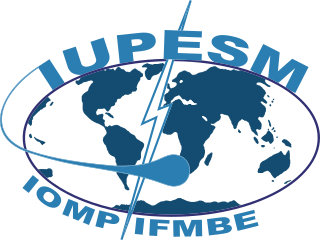Medical physics deals with the application of the concepts and methods of physics to the prevention, diagnosis and treatment of human diseases with a specific goal of improving human health and well-being. Since 2008, medical physics has been included as a health profession according to International Standard Classification of Occupation of the International Labour Organization.
BioMed Central (BMC) is a United Kingdom-based, for-profit scientific open access publisher that produces over 250 scientific journals. All its journals are published online only. BioMed Central describes itself as the first and largest open access science publisher. It was founded in 2000 and has been owned by Springer, now Springer Nature, since 2008.
Gabor Tamas Herman is a Hungarian-American professor of computer science. He is Emiritas Professor of Computer Science at The Graduate Center, City University of New York (CUNY) where he was Distinguished Professor until 2017. He is known for his work on computerized tomography. He is a fellow of the Institute of Electrical and Electronics Engineers (IEEE).

Chonnam National University is one of ten Flagship Korean National Universities located in Gwangju and South Jeolla Province, South Korea. In March 2006, Yeosu National University merged with Chonnam National University to become a satellite campus. CNU ranked the 10th nationwide and the 420th worldwide in world university rankings in the CWUR. It was also the 1st among the nine Korean national flagship universities in "Asia’s Top 75 Most Innovative Universities" in 2017 Reuters. CNU has also expanded its global reach by establishing partnerships with 499 Universities in 62 countries as of 2019.
The Archives of Sexual Behavior is a bimonthly peer-reviewed medical journal in sexology. It is the official publication of the International Academy of Sex Research.

The Institute of Physics and Engineering in Medicine (IPEM) is the United Kingdom's professional body and learned society for physicists, engineers and technologists within the field of medicine, founded in 1995, changing its name from the Institution of Physics and Engineering in Medicine and Biology (IPEMB) in 1997. The Institute is governed by an elected Board of Trustees reporting to which are the Science, Research and Innovation Council and the Professional and Standards Council. The councils have operational responsibility for scientific and professional aspects of the Institute's work, respectively. Beneath the councils is a substructure of committees, groups and panels of members, which undertake the work of the Institute.

Russ Biagio Altman is an American professor of bioengineering, genetics, medicine, and biomedical data science and past chairman of the bioengineering department at Stanford University.

Medicon Valley is a leading international life-sciences cluster in Europe, spanning the Øresund Region of eastern Denmark and southern Sweden. It is one of Europe's strongest life science clusters, with many life science companies and research institutions located within a relatively small geographical area. The name has officially been in use since 1997.
The Federation of American Societies for Experimental Biology (FASEB), based in Rockville, Maryland, is a non-profit organization of scientific societies in the United States. With a focus on the biological and biomedical sciences, the federation represents scientists in such fields as anatomy, physiology, immunology, biochemistry, molecular biology, toxicology, genetics, and nutrition.

The International Federation of Medical and Biological Engineering (IFMBE) was initially formed as International Federation for Medical Electronics and Biological Engineering during the 2nd International Conference of Medical and Biological Engineering, in the UNESCO Building, Paris, France in 1959. It is primarily a federation of national and transnational organizations. These organizations represent national interests in medical and biological engineering.

The International Union for Physical and Engineering Sciences in Medicine (IUPESM) is an international non-governmental organization - the umbrella organization for the International Organization for Medical Physics (IOMP) and International Federation of Medical and Biological Engineering (IFMBE).

Tamara Minko is a distinguished professor and chair of the department of pharmaceutics at Rutgers University, Ernest Mario School of Pharmacy. She has an H-index of 43 since 2016 and over 17,800 citations of her work.
Physical and Engineering Sciences in Medicine is a quarterly peer-reviewed medical journal covering research in medical physics and biomedical engineering. It is the official journal of the Australasian College of Physical Scientists and Engineers in Medicine and is recognized as an official journal of the International Organization for Medical Physics, Asia-Oceania Federation of Organizations for Medical Physics and the Biomedical College of Engineers Australia.

The Canadian Medical and Biological Engineering Society (CMBES) is a technical society representing the biomedical engineering community in Canada. CMBES is supported by its membership which consists of biomedical engineers, biomedical engineering technologists and students. CMBES also hosts an annual conference and regular webinars. It produces a number of publications including the Clinical Engineering Standards of Practice and a Newsletter. The Society's aims are twofold: scientific and educational: directed toward the advancement of the theory and practice of medical device technology; and professional: directed toward the advancement of all individuals in Canada who are engaged in interdisciplinary work involving engineering, the life sciences and medicine.
Ioannis (Yannis) C. Paschalidis is a professor at Boston University with appointments in Electrical and Computer Engineering, Systems Engineering, Biomedical Engineering, and Computing & Data Sciences. He serves as the Director of the Center for Information and Systems Engineering.
Science Publishing Group (SPG) is an open-access publisher of academic journals and books established in 2012. It has an address in New York City and many of its journals are named American Journal of..., but the company is actually based in Pakistan. The company has been criticized for predatory publishing practices. As of 2019, it publishes 430 journals in various fields.

Leslie Ying is an American biomedical engineering scientist in the field of medical imaging. She is the Clifford C. Furnas Professor of Biomedical Engineering and Electrical Engineering at University at Buffalo, The State University of New York. Ying is the Editor-in-Chief of IEEE Transactions on Medical Imaging and is also an American Institute for Medical and Biological Engineering (AIMBE) Fellow.

The MICCAI Society is a professional organization for scientists in the areas of Medical Image Computing and Computer Assisted Interventions. Due to the multidisciplinary nature of these fields, the society brings together researchers from several scientific disciplines. including computer science, robotics, physics, and medicine. The society is best known for its annual flagship event, The MICCAI Conference, which facilitates the publication and presentation of original research on MICCAI-related topics. However, the society provides endorsements and sponsorships for several scientific events each year.










